FOMC Minutes Reveal Split Fed, But More Rate Cuts Likely in 2025
The FOMC minutes from the Federal Reserve’s September 16–17 meeting paint a nuanced picture: the Fed is divided internally over how aggressively to cut interest rates, but the majority still expect further rate cuts in 2025. The minutes underscore lingering concerns about inflation, diverging views on economic strength, and increased attention to signs of labor market weakness.
Key Takeaways from the Minutes
1. Split Views Among Policymakers
While the FOMC approved a 25 basis point cut in September (bringing the target range to 4.00%-4.25%) with an 11–1 vote, the minutes show that several officials believed they could have held steady.
- Governor Stephen Miran dissented in favor of a 50 bps cut.
- A few participants thought that inflation progress had stalled, and preferred a more cautious stance.
- Others believed that financial conditions already showed some easing and that further cuts should be gradual.
In other words, the Fed is not monolithic; some are hawkish, others dovish. The minutes emphasize that the committee is balancing the risk of moving too quickly versus falling behind due to economic weakness.
2. Justification for Cutting Rates
Despite concerns over inflation, several factors motivated the rate cut decision:
- Many officials judged that the risks of labor weakness had increased enough to warrant easing policy.
- Some participants noted that inflation pressures, including those linked to tariffs, might be easing or already priced in.
- A majority believed it would be “appropriate to ease policy further over the remainder of the year,” though the pace and size of cuts weren’t fixed.
However, the minutes also show that upside risks to inflation remain a meaningful concern. Several officials cautioned that lower rates too fast could unsettle inflation expectations.
3. Outlook: More Cuts Expected in 2025
The market reaction to the minutes was largely dovish. Traders and analysts interpret the text as signaling two additional cuts this year.
The “dot plot” from the September meeting also reflected this split: approximately 10 policymakers favored two more cuts, while 9 favored fewer or no cuts.
That said, there is still considerable caution: any further action will be deeply data dependent, especially on inflation readings, employment metrics, and broader economic strength.
How This Impacts the Stock Market & Sector Sentiment
Implication for Equities
A more accommodative Fed tends to benefit equity markets, especially growth and technology sectors. Lower rates reduce discount rates, which can increase present valuations of future cash flows. That dynamic may favor AI stocks and high-growth names.
Yet, divisions within the Fed raise the risk of policy surprises, which could lead to intra-year volatility.
Influence on Stock Research & Positioning
For analysts doing stock research, the Fed’s path is a key input for earnings forecasts, discount rates, and sector rotation models. With rate cuts more likely, analysts may tilt forecasts more positively for interest rate-sensitive sectors (like real estate, consumer discretionary) and cautious projections for financials or banks.
Sector Rotation & Capital Flows
- Cyclicals, small caps, and high-beta names may enjoy renewed interest if rate cuts materialize.
- Defensive stocks (utilities, consumer staples) may give some ground if growth sectors retrace upward.
- Financials have a complex relationship; lower rates reduce net interest margins, but may stimulate loan growth.
Risks & Watchpoints
Inflation Surprises
The biggest caveat is inflation volatility. If inflation rebounds (or remains sticky), the Fed may pause or even reverse cuts.
Economic Data Inconsistency
Some key data releases have been delayed or distorted lately (e.g., due to government shutdowns), making real-time assessment harder.
Divergence Among Fed Officials
Because the Fed is split, a shift in tone by a few members could swing the balance. Investors must monitor Fed speeches, minutes, and internal signals closely.
Global or External Shocks
Any external shock, such as geopolitical risks, supply chain disruptions, or energy volatility, could force the Fed to alter its path unexpectedly.
Conclusion
The recent FOMC minutes lay bare a delicate balancing act at the Fed. While a majority of officials lean toward further rate cuts in 2025, internal splits and inflation concerns mean the path forward will be cautious and data-driven. For the stock market and sector forecasts, this suggests opportunity tempered by risk, especially for AI stocks and growth plays. Stock research models must now build in both upside flexibility and downside guardrails.
Investors who follow macro cues closely and remain nimble will likely be better positioned for the twists ahead.
FAQs
The FOMC minutes are the detailed record of discussions among the Federal Open Market Committee members during their policy meeting. These minutes often reveal internal views, disagreements, and rationales behind decisions.
Interest rates influence borrowing costs, consumer spending, business investment, and valuations. Lower rates often boost equities, especially growth and tech sectors.
Yes. If inflation rebounds strongly or overshoots, the Fed may delay cuts, pause, or even consider tightening again, depending on conditions.
Disclaimer:
This content is made for learning only. It is not meant to give financial advice. Always check the facts yourself. Financial decisions need detailed research.






